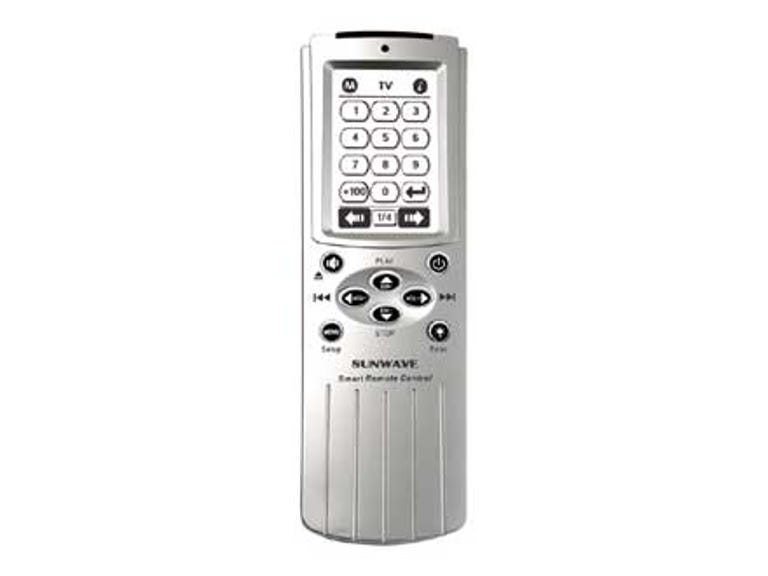 Why You Can Trust CNET
Why You Can Trust CNET Sunwave SRC-7000 review: Sunwave SRC-7000
The SRC-7000 may have the ability to control 64 devices, but we couldn't get it to satisfactorily handle even eight.
Design
The blurb for the Sunwave SRC-7000 says that the unit is capable of controlling up to 64 devices -- that's great, all we needed it to do is control eight. This would prove to be not as easy as it sounds. The design of the remote is simple enough: eight rubberised buttons, with the rest of the changing functions handled via the programmable touch screen display at the top of the unit. The display is a fairly rudimetary black and white one that, strangely enough, seemed almost more difficult to read with the backlight on. Adjusting the brightness helps a bit, but the display is difficult to read in almost any light (and because it is recessed slightly, it is not all that easy to operate either).
The Good
The Bad
The Bottom Line
The design of the charger dock is slightly odd -- the remote pokes out of it like a pencil in a cup. But I suppose this makes it slightly easier to grab when you need it (as long as it's not placed somewhere where it's going to get knocked around a lot).
The buttons used to navigate through the unit's different menus provide very little feedback -- we often found ourselves wondering whether we had pressed the button hard enough, or whether it was registering at all. Part of this has to do with the navigation system, which we will get to later.
Features
The unit comes with accessories such as the dock for storing the remote, which keeps the batteries charged, and a USB cable for communication with a PC. Installing the provided software enables you to use the PC to create custom touch screen designs, though with some fairly strict limitations. You can do this from remote too -- if you've got plenty of time and patience. That's really all the PC software does -- that, and save the settings in case your remote batteries should ever go completely flat (though why settings should ever be lost with 1MB of flash memory, I don't know -- yet we managed it). There is also an "upgrade tools" package you can install to get the latest product models and codes over the Internet.
In addition to giving the ability to program individual devices, the Sunwave-7000 also lets you create custom macros, each of which can store up to 60 commands, including time delays.
Performance
There are two ways a universal remote can acquire the ability to control devices: by associating codes with each individual device, or by "learning" individual codes sensed from existing remotes. We tend to like the learning method for training universal remotes because it's a fairly simple and straightforward process, and because the available codes seem rarely to contain the ones for the devices you want to control.
The code method of programming the Sunwave SRC-7000 was frustrating. Say you wanted to discover the code for your television -- you would set the remote up, point it at the powered-on TV, wait as the remote cycled through possible codes, and scramble for the right button when the TV suddenly turned off. If your mind didn't wander and you caught it in time, you had a pretty good estimation of the TV's code (estimation because it didn't always work properly for all controls). The other problem was, for two of our test components, the remote never did find the right code. Even more maddeningly, the remote would not "learn" all the necessary functions for these devices either (it learned some).
We're pretty certain that some of the problems might have been able to have been corrected with lots more time and effort, but the navigation system when programming -- and even during setup of the remote itself -- is so unintuitive and downright illogical that we found it very difficult to persevere. Both the "helpful" explanations that pop up occasionally on the remote display, and those in the User's Guide are often of the "what langauge was this translated from?" variety and don't provide a lot of help. And the multitude of confusing icons displayed on the remote at various times provide almost no indication as to what the unit is doing or what it might be asking you to do.
Oddly, while scouring the Web to find answers to the many questions that popped up during testing of this unit, we found comments from several people who said they found the SRC-7000 to be a very competent universal remote. We can only guess that either these were employees of Sunwave, or they are those who have not yet discovered the many other universal options out there.


